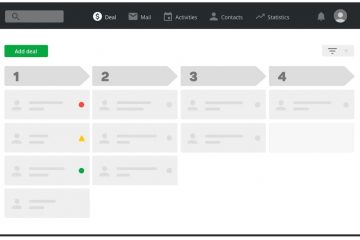Sales Velocity – The Many Benefits of a Single Metric
Fundamentally, you can say that a business is all about what resources you have, resources you can procure, and how you convert these resources into products and services. Resources play a big part in determining how successful your business will be.
This makes it necessary to not only ensure a regular and flexible supply of resources to meet the fluctuating market demands but also to manage them well. Business resources carry a lot of value and aren’t easy to procure. So, managing them properly becomes essential for all.
Conventional resources such as raw materials, consumables, and human resources are given a lot of importance and consideration in the business world. However, there is a far more important resource that often gets overlooked; that resource is time.
Considering the fact that you cannot source more time unlike other resources, more consideration must be given to managing and conserving it. Timing is significant, especially when it comes to sales. Selling fast and quick has many advantages for your business.
But how do you measure, track and quantify a resource like time? For that, we have a performance indicator known as Sales Velocity that will not only help you understand how you’re using time but will also let you assign value to the ‘time’ resource being utilized by your business.
What is Sales Velocity?
Sales Velocity can be defined as the measurement of how fast leads are moving through a firm’s sales pipeline and resulting in revenue generation. It helps measure the overall effectiveness of a firm’s sales pipeline in terms of how many leads it handles and the revenue it generates in a specific time interval.
The formula for Sales Velocity goes as follows:
Sales Velocity = (Number of Opportunities X Deal Value X Conversion Rate) / Length of Sales Cycle
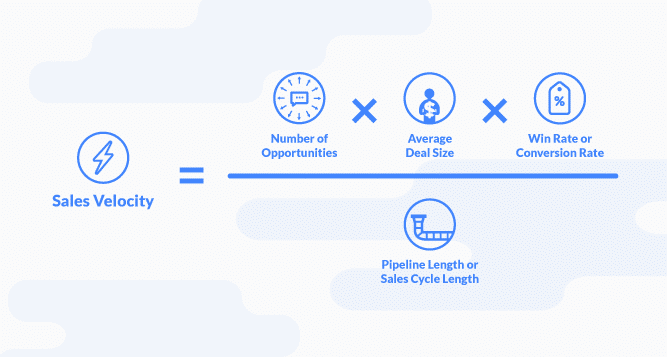
Image Courtesy – Marketo
Sales Velocity as a Key Performance Indicator can reveal a lot about how your business’s sales function works and helps you determine its performance and gauge its efficiency. The learned insights can be used to help sales function perform better.
Variables determine Sales Velocity
Number of Opportunities
Every sales pipeline has a number of opportunities that are moving through it at any given time, being handled by your sales team. Opportunities are the qualified leads that your sales team is pursuing in order to convert them into paying customers.
It is crucial that leads are qualified before being engaged by the sales team, as engaging unqualified leads will not only slow down your sales velocity but also make the process of calculating sales velocity inaccurate.
These leads can be further broken down into segments classified by region, product, or role. This helps a business understand how each segment is performing and which segments need attention in order to boost Sales Velocity.
Average Deal Value
A business’s average deal value refers to the average revenue generated from every customer. This value depends from industry to industry and on the number of products and services a business has to offer in the market.
It is fairly easy to calculate the average deal value; you have to consider a fixed time interval and divide the total revenue generated in that interval by the number of deals closed in that interval. If you are selling recurring subscriptions, you can use Lifetime Value (LTV) for the calculation.
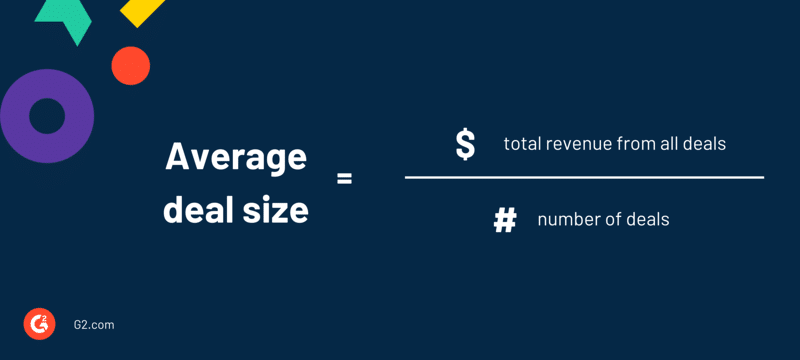
Image Courtesy – G2
The average deal value is a variable that cannot be adjusted much as it mostly depends upon product and service pricing, which are in turn dictated by the demand for them in the market. So, a business, especially one that has an active go-to-market strategy, has little control over this variable.
Though this variable is relatively irrelevant when it comes to maximizing sales velocity, a business can use it to assess whether the marginal cost of customer acquisition is justified when considering marginal revenue generated.
Conversion Rate
As a standalone indicator, conversion rate directly represents the overall effectiveness and efficiency of a business’s sales function in most cases. This indicator can be used to understand and improve the sales function by making changes to the sales process or adapting a better strategy.
To simply put it, conversion rate represents how many leads were converted into sales against the total number of leads a business’s sales team engaged. A low conversion rate reflects various problems within the sales function that need to be identified and dealt with. A low conversion rate is harmful to your business.
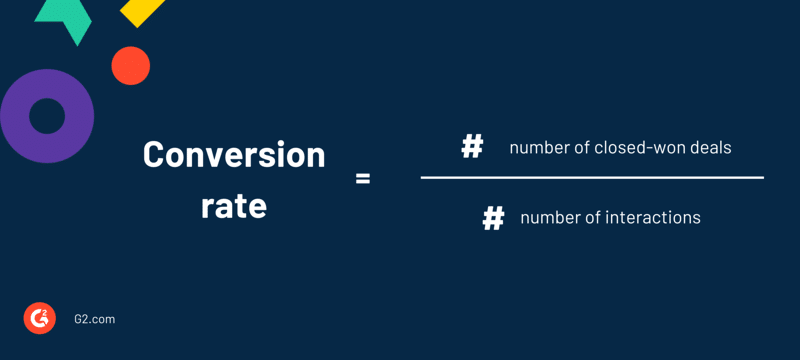
Image Courtesy – G2
Qualifying leads properly is a simple step that can drastically improve a firm’s conversion rate. It can further be improved upon by overhauling the sales process, improving price and product mix, or providing advanced sales training for the members of the sales team.
Processes such as Sales Monitoring can also be incorporated to assess and manage the sales pipeline better and plug holes in the sales funnel to ensure lead spill out is avoided under any and all circumstances.
Sales Cycle Length
The length of a sales cycle also termed as sales pipeline length, is the duration it takes for a prospect to turn into a customer. This length varies highly from one business segment to another.
Retail and consumer sectors have the shortest sales cycles while B2B and Business to Government sectors have long cycles. Sales cycle length is inversely proportional to the sales velocity.
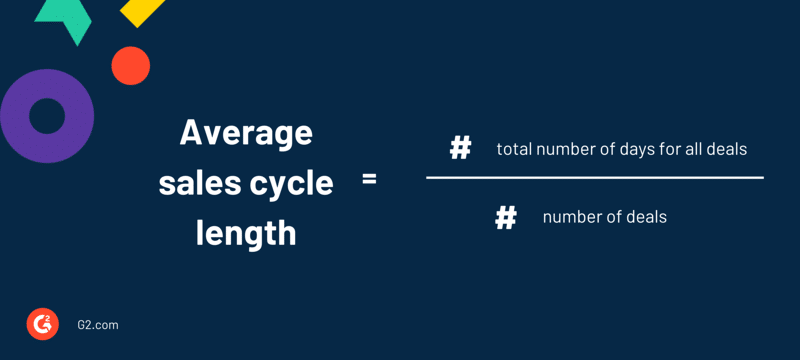
Image Courtesy – G2
A shorter sales cycle is highly desirable for any business, and there are numerous ways in which this can be achieved. Changes in strategy, using AI and automation, hiring better sales executives, or better training the existing ones are some ways to do it.
If your sales cycle is longer than the average in your industry, you need to identify the choke points and relieve them to ensure an unrestricted flow of leads through the pipeline. This can be done by eliminating unnecessary steps in the process.
How can tracking Sales Velocity help you improve your business?
Sales velocity is a multifaceted performance metric. As a whole, it shows you how the overall performance of your sales function is, while the component metrics used to calculate Sales Velocity help you understand the performance of each core component of your sales function.
This gained insight can be used to improve the following aspects of your sales function:
Sales Process Overhauls
A slow Sales Velocity is an indicator of inherent problems in a firm’s sales process. It may be excess paperwork, manual lead qualification, or other issues that may be weighing down leads, making them slow as they move through your pipeline.
When identified, these issues can be dealt with by eliminating unnecessary paperwork and steps, automating functions like lead management and qualification, and creating a faster framework that allows leads to move swiftly through your pipeline.
Sales Team Training Requirements
It is simple to calculate sales velocities for each sales representative, so those with a slower sales velocity can be put up for better one-on-one sales training so they can develop their communication and negotiation skills.
In some instances, you can train the sales team using different tactics depending upon the region or product they handle. These tactics can be tailored to suit what the sales representatives are handling in order to speed up their sales velocities.
Hiring Requirement
The multifaceted nature of Sales Velocity as an indicator is really helpful. If your firm exhibits a higher number of sales opportunities and a slow sales velocity, it is a clear indicator of the inadequacy of your sales team to handle all incoming leads.
An overworked sales team will not be efficient, and hence hiring more people will not only reduce their work stress but raise their efficiency. Moreover, your firm will be able to handle more leads which will raise productivity and boost sales velocity.
Problems with Product and Pricing Mix
The average deal value, though relatively irrelevant to sales velocity, as earlier stated, can help you understand if there are issues with your product and pricing mix. A lower average deal value, when compared to your industry, means there are problems, either with pricing or the value your product offers.
This can be dealt with by providing a better product that actually provides value and utility or changing the pricing to better suit the supply and demand dynamics of your product.
Calculating and Tracking Sales Velocity
Calculating Sales Velocity is quite simple; you need to decide on a specific time interval and calculate the component metrics beforehand. Then you can use the Sales Velocity Formula to calculate Sales Velocity for that specific time interval.
Let us consider some examples:
Let’s assume you have a B2B business, and for this month, you have in all 25 qualified leads in your pipeline with the average deal value of $4000, conversion rate at 40%, and the average sales cycle is 19 days long.
Using the Sales velocity formula we have,
Sales Velocity =
(Number of Opportunities X Deal Value X Conversion Rate) / Length of Sales Cycle
(25 X 4000 X 0.40) / 19 = (40000)/1
Sales Velocity = $2105 per day.
Now that you know how Sales Velocity is calculated for a month, you can use the same approach to calculate the same on a weekly or quarterly basis. And you can periodically compare the results.
There are plenty of Sales Monitoring products that allow for customized reporting, so you can opt for any one of those that will enable you to track and monitor sales velocities of the sales team as a whole or individual sales reps.
To Sum It All Up
Sales Velocity is a multifaceted performance metric that helps you monitor the overall performance of sales function and its core components.
A lot of insight can be gained using sales velocity based on which changes can be made to improve your business.
It is easy to set up, calculate and can be automated entirely using a Sales Monitoring Software Solution. Regular Monitoring will help you set achievable targets, scale steadily and grow constantly.
Sell more, understand your customers’ journey for free!
Sales and Marketing teams spend millions of dollars to bring visitors to your website. But do you track your customer’s journey? Do you know who buys and why?
Around 8% of your website traffic will sign up on your lead forms. What happens to the other 92% of your traffic? Can you identify your visiting accounts? Can you engage and retarget your qualified visitors even if they are not identified?
